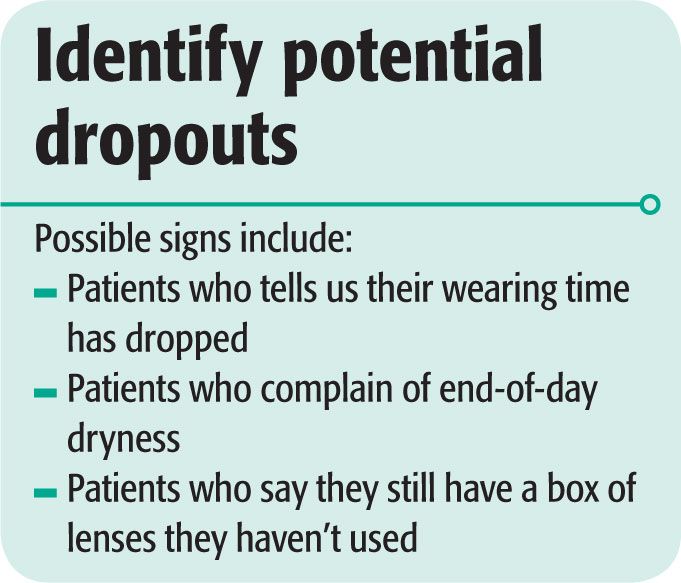Dropouts-not in my practice
We have talked about dropouts in contact lens practice since we started fitting lenses. Jason Nichols, OD, said 16% of contact lens wearers permanently drop out of lens wear each year.1 Many others quote 15-30% of lens wearers drop out each year.

We have talked about dropouts in contact lens practice since we started fitting lenses. Jason Nichols, OD, said 16% of contact lens wearers permanently drop out of lens wear each year.1 Many others quote 15-30% of lens wearers drop out each year. John Rumpakis, OD, conducted an extensive survey in 2010 on dropout rates. He found that 17% of lens wearers were dropping out permanently from lens wear.2 If we are seeing about 20% new contact lens fits a year, we are barely keeping even in our practices. If you want to feel ill, start adding up the lost revenue.
Crunching the numbers
If we take an average contact lens patient, assume the patient returns every 15 months, and has a 10-year lifetime in the practice, that equates to 8 visits. Now assume the patient spends about $400 at each visit, and purchases glasses 3 times in the 10 years at about $500 each time. This equals $4,700, what the average contact lens patient will spend in your office over 10 years. Assuming your practice sees 600 contact lens patients per year, then losing 20% a year can be a loss of 120 patients. The loss revenue grows exponentially and ends up being in the millions over the 10-year-period. We work so hard to get the patient into our office, it make sense to stop this bleeding.
Identifying dropouts before they happen
The key is to identify those in our practices who are potential dropout victims. There are many signs we must pay attention to:
• Patients who tells us their wearing time has dropped
• Patients who complain of end-of-day dryness
• Patients who say they still have a box of lenses they haven’t used
These are all opportunities to prevent our patients from needlessly ending their contact lens wearing. Staff conversations are critical-staff often will elicit responses that our patient may be embarrassed to tell us. Make sure the staff notes these types of comments.
Ensure staff talks to patients about:
• New technology in lenses
• Materials which help people with dry eyes
• Success with multifocal designs
We need to create the excitement the patient had when he first asked to wear contact lenses.
Ask questions, listen to the answers
Once the patient is in your exam chair, ask questions to get the truth about their lens wear. Ask when he removes his lenses; if he says he can’t wait to get home and take them out, you have elicited much better information than, “I wear my lenses 12 hours a day.” Now, we can fix a problem and create a happy patient. We tend to get lazy because we are so busy and know that there is another patient waiting for us in the next room. We don’t spend the extra 2 minutes it takes to really find out how the patient is doing with his lenses.
We are in a new golden age of contact lens technology. We have seen new developments in lens materials and designs. New multifocal designs have the ability to keep the presbyope in contact lenses for many more years. Daily disposables have become very affordable and are a great assist for many of our challenging patients. And don’t forget about the vast new technologies in gas permeable lenses. Semi-scleral and scleral lenses have kept many people in lens wear who may have gone to surgical options instead. We also have new solutions, which help keep the lenses cleaner and wetter than older products. It is important to prescribe the solution as well as the lens to show how important lens care is to overall wearing success.
Doctors, we can complain all we want about patients buying off the Internet or at big box chains, but dropouts are our problem. We need to address this problem head on. We need to actively recommend what is best for our patient and not be so concerned about costs and availability. When we do what is in our patients’ best interest, it always ends up being best for our practice.ODT
References
1. Nichols JJ. 2010 Annual Report on Dry Eye Diseases. CL Spectrum. 2010 Jul;15(8):22.
2. Rumpakis J. New data on contact lens dropouts: an international perspective. Rev Optom. 2010 Jan;147(1):37-42.
Identify potential contact lensdropouts. Possible signs include:
• Patients who tells us their wearing time has dropped
• Patients who complain of end-of-day dryness
• Patients who say they still have a box of lenses they haven’t used
Newsletter
Want more insights like this? Subscribe to Optometry Times and get clinical pearls and practice tips delivered straight to your inbox.